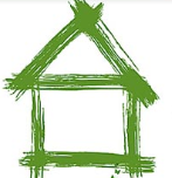
The American Society of Interior Designers publishes a regular news magazine for its members. Recently, an article in ICON magazine by Michael Behrens highlighted the marriage between aging-in place, universal design and sustainable environments.
Here's some of what Michael had to say....and thanks for the shout-out !!
Like trains running on parallel tracks, sustainable design and Universal Design have been coursing their separate ways through the A&D community, gradually picking up steam over the years. At last, they have caught up with each other at a crossroads called Design-for-Aging, and the timing couldn’t be more fortuitous.
Although few would have thought much about it 20 years ago, sustainable design and design for aging are ideally suited for one another. What’s more sustainable than helping someone to remain in their home rather than move to a new building or facility? Beyond that, many of the features and products available today complement both sustainable and universal solutions. Add to the mix the aging of the eco-aware baby boomers and you have a match made in design heaven.
SHADES OF GREY AND GREEN
Despite the obvious benefits, selling older homeowners on green and sustainable options does not come easy. Surveys of homeowners 50 and over show that the plurality of older Americans do not place a high priority on green or sustainable design features when considering purchasing or remodeling a home. At the same time, when asked what they do want most, they give a very high ranking to saving on energy and water costs, a healthy environment and ease of maintenance. In other words, what has been true of universal or accessible design for older clients for years is also true of sustainable design: They don’t want to pay for the idea, but they will pay for the benefits.
Surprisingly perhaps, this also holds true for baby boomers. Boomers did not invent the environmental movement, but they grew up with it through the 70s and beyond, coming of age during the gas shortages, energy crises, blackouts and brownouts, oil spills, global warming, and so on. Nonetheless, boomers as a group say they are not more inclined to pay extra for a green home unless they can be shown that the cost will be offset by energy or other savings later on or that the home will increase in value as a result.
This past October, the ASID California San Diego Chapter participated in a daylong “Green Retirement” workshop — “a retirement planning event with an environmental twist” — along with AARP California and Revisions Resources, a local nonprofit agency that provides information and support to older San Diegans. In this case, “green” stood for sustainable and, yes, dollars. The pitch: Get financial planning and management advice AND learn how to save money while saving energy. “Interior designers from ASID will discuss how to make your home safe, comfortable, and sustainable,” declared the announcement on the AARP website. For retirees living on a fixed income, money talks louder than environmentalism.
FUNCTIONAL AND FRUGAL
When dealing with older clients, therefore, it is important to focus on the monetary, health and design benefits of green and universal solutions. States Michael Thomas, FASID, co-author of Design for Residential Aging in Place and president of the Design Alliance for Accessible Sustainable Environments (DAASE), an organization that promotes independent living through the design of safe, secure and sustainable environments, “By making a few simple choices such as high efficiency appliances, solar-supportive power sources, low-maintenance fabrics and furnishings, and interior finishes that support good indoor air quality, boomers will be able to live in their own healthy places for a much longer period of time.”
Want to read more? CLICK HERE
Here's some of what Michael had to say....and thanks for the shout-out !!
Like trains running on parallel tracks, sustainable design and Universal Design have been coursing their separate ways through the A&D community, gradually picking up steam over the years. At last, they have caught up with each other at a crossroads called Design-for-Aging, and the timing couldn’t be more fortuitous.
Although few would have thought much about it 20 years ago, sustainable design and design for aging are ideally suited for one another. What’s more sustainable than helping someone to remain in their home rather than move to a new building or facility? Beyond that, many of the features and products available today complement both sustainable and universal solutions. Add to the mix the aging of the eco-aware baby boomers and you have a match made in design heaven.
SHADES OF GREY AND GREEN
Despite the obvious benefits, selling older homeowners on green and sustainable options does not come easy. Surveys of homeowners 50 and over show that the plurality of older Americans do not place a high priority on green or sustainable design features when considering purchasing or remodeling a home. At the same time, when asked what they do want most, they give a very high ranking to saving on energy and water costs, a healthy environment and ease of maintenance. In other words, what has been true of universal or accessible design for older clients for years is also true of sustainable design: They don’t want to pay for the idea, but they will pay for the benefits.
Surprisingly perhaps, this also holds true for baby boomers. Boomers did not invent the environmental movement, but they grew up with it through the 70s and beyond, coming of age during the gas shortages, energy crises, blackouts and brownouts, oil spills, global warming, and so on. Nonetheless, boomers as a group say they are not more inclined to pay extra for a green home unless they can be shown that the cost will be offset by energy or other savings later on or that the home will increase in value as a result.
This past October, the ASID California San Diego Chapter participated in a daylong “Green Retirement” workshop — “a retirement planning event with an environmental twist” — along with AARP California and Revisions Resources, a local nonprofit agency that provides information and support to older San Diegans. In this case, “green” stood for sustainable and, yes, dollars. The pitch: Get financial planning and management advice AND learn how to save money while saving energy. “Interior designers from ASID will discuss how to make your home safe, comfortable, and sustainable,” declared the announcement on the AARP website. For retirees living on a fixed income, money talks louder than environmentalism.
FUNCTIONAL AND FRUGAL
When dealing with older clients, therefore, it is important to focus on the monetary, health and design benefits of green and universal solutions. States Michael Thomas, FASID, co-author of Design for Residential Aging in Place and president of the Design Alliance for Accessible Sustainable Environments (DAASE), an organization that promotes independent living through the design of safe, secure and sustainable environments, “By making a few simple choices such as high efficiency appliances, solar-supportive power sources, low-maintenance fabrics and furnishings, and interior finishes that support good indoor air quality, boomers will be able to live in their own healthy places for a much longer period of time.”
Want to read more? CLICK HERE

 RSS Feed
RSS Feed